Get ready for a truly immersive TV experience with HDTV Today. Our comprehensive guide will help you find the perfect high-definition TV to meet all your entertainment needs. Say goodbye to low-quality images and subpar sound – our expert advice will help you discover the ultimate viewing experience. Start your quest for the perfect HDTV today and take your entertainment experience to new heights.
Considering an upgrade to a new high-definition television (HDTV) today? This transition can introduce a whole new realm of entertainment to your living room. With many options on the market, the curiosity about “How to buy an HDTV?” may arise. But worry not! This guide aims to assist in solving the jargon and finding the best TV for your needs. We’ll examine various TV types, highlighting their unique features, and offer tips to consider before making your final decision. Let’s simplify purchasing an excellent TV, making it as effortless as enjoying your favorite show!
What will you see here?
What is HDTV?
HDTV or High-Definition Television, has revolutionized how we experience television content. It refers to a broadcasting system offering significantly higher resolution and image quality than traditional TV formats. The primary distinction lies in its increased pixel count, providing clearer, more detailed pictures and enhanced color reproduction.
It typically has a wider aspect ratio, resulting in a more cinematic experience that feels like you’re in a movie theatre. Additionally, its utilization of digital signals enhances efficiency and reduces susceptibility to noise compared to analog signals.
The widespread acceptance of HDTV has set a new standard for home entertainment, providing viewers with an elevated and improved way to indulge in their favorite programs and movies.
Types of HDTVs
HDTVs give you plenty of choices to choose from, each offering unique features and viewing experience. Let’s have a detailed breakdown of its types:
LED-LCD TVs
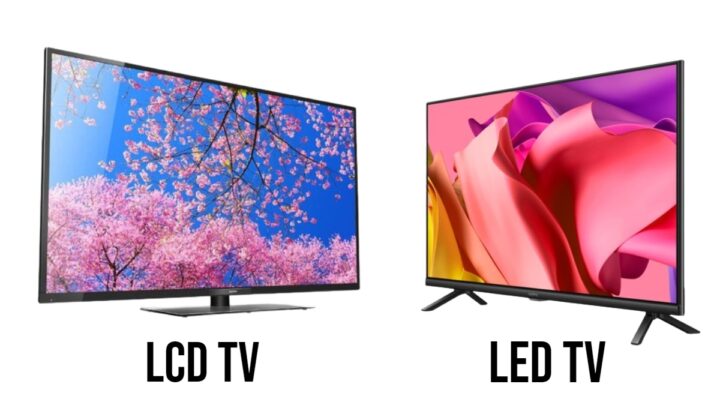
To begin with, let’s begin with the most prevalent and fundamental choice for consumers when selecting a TV. LED and LCD TVs have seen remarkable advancements and improvements. The main advantage of LED-LCD TVs is their brightness control. They offer better control over backlighting, allowing for darker black scenes, and significantly enhancing contrast and overall picture quality.
LED-LCD TVs come in various forms, including edge-lit and full-array backlighting. Edge-lit TVs have LEDs around the edges of the screen, while full-array backlighting places LEDs uniformly across the entire panel, providing more precise control over local dimming and improving picture quality.
Moreover, the introduction of Mini LEDs in LED-LCD TVs is taking local dimming a step further. By packing thousands of tiny LEDs into the backlight, it creates numerous dimmable zones for better control. This boosts the TV’s dynamic range, showcasing brighter whites and deeper blacks
Despite their advantages, it’s essential to consider factors like panel quality, refresh rates, and HDR (High Dynamic Range) capabilities when choosing an LED-LCD TV. These elements contribute to the overall viewing experience, ensuring smooth motion handling and vibrant color reproduction.
OLED TVs

Picture Credit: Tailor-Made Audio and Video Inc.
OLED TVs have redefined the viewing experience with their stunning picture quality and innovative technology. Unlike traditional LED TVs, OLED displays use organic compounds that emit light when an electric current passes through them. What sets OLED apart is its ability to individually control each pixel’s illumination, allowing for perfect blacks and incredibly vibrant colors.
This self-emissive nature means that when a pixel needs to display true black, it simply turns off, resulting in unparalleled contrast and a strikingly lifelike picture. The absence of a backlight also means wider viewing angles, ensuring consistent image quality from nearly any perspective.
Moreover, the technology’s response time is exceptional, making it ideal for watching fast-paced action scenes or gaming, where smooth motion is crucial. However, OLED TVs tend to be more expensive than conventional LED TVs, their exceptional picture quality and innovative technology are worth it, making it a compelling choice for individuals seeking a premium home entertainment experience.
QLED TVs
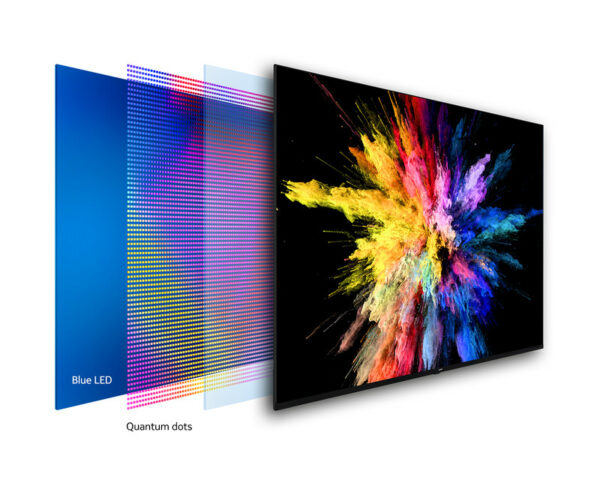
QLED TVs are quite a fascinating piece of technology. They use tiny semiconductor particles called quantum dots to improve picture quality. These dots are incredibly small and emit differently when powered. When the TV backlight hits these dots, they illuminate and create the colors you see on the screen.
QLED TVs stand out for their remarkable capacity to render an extensive spectrum of colors with exceptional accuracy. They typically boast outstanding brightness levels, making them well-suited for brightly lit rooms without compromising on picture quality. Also, QLED TVs typically have better viewing angles compared to traditional LED TVs, ensuring a more consistent picture quality even when viewed from the sides.
Many manufacturers like Samsung, have been pushing the boundaries of QLED technology, enhancing features like contrast ratios and refining the overall viewing experience. Plus, the integration of smart TV capabilities in QLED models allows users to access streaming services, apps, and other content directly from their television.
However, do not let the similar names of OLED and QLED fool you! QLED TVs are a part of the LCD TV family.
Plasma TVs
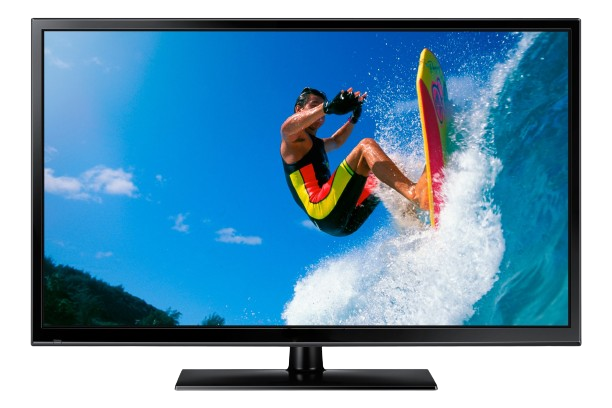
Plasma TVs were once the darlings of home entertainment. They offered stunning picture quality, deep blacks, and vibrant colors that made movie nights feel like a cinematic experience. However, they faced challenges with energy efficiency and had issues with screen burn-in, where static images could leave a lasting impression on the screen.
Despite their impressive visuals, they were eventually overtaken by LED and OLED technologies due to advancements in those areas. Now, if you’re seeking a vintage tech treasure, you might find a few plasma TVs, but for modern viewing pleasure, LED and OLED have taken the spotlight.
Key Features to look for while purchasing an HDTV
When diving into the world of HDTVs, there are several essential features to consider before making a decision:
Screen size:

The foremost and crucial aspect to consider is the screen size. Imagine you bought a TV that’s too large for your space or vice versa. Ultimately, the size of your TV depends on the room and your viewing distance. A bigger screen offers a more immersive experience, yet if it’s oversized for your area, you might compromise picture quality. Moreover, there are standard guidelines available for viewing distances determined by screen size to guarantee an optimal viewing experience.
Screen resolution:
Higher resolution means a sharper image. Full HD (1080p) has remained the standard, providing excellent clarity. Nevertheless, 4K Ultra HD has gained immense popularity due to its exceptional detail. It enhances the clarity, especially on larger screens.
HDR:
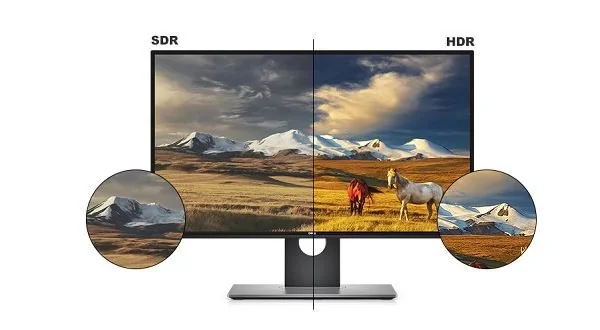
Picture Credit: Reddit
HDR enhances contrast and color accuracy, offering a wider range of colors and brighter highlights. It significantly improves the picture quality by providing more depth and realism, especially in scenes featuring vivid highlights and deep shadows. Moreover, various HDR formats, such as HDR10, Dolby Vision, or HLG are also available, each with distinct capabilities.
Refresh rate:
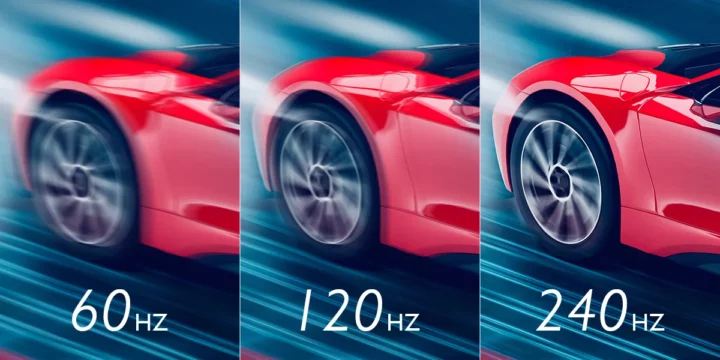
Picture Credit: BenQ
Measured in Hertz (Hz), the refresh rate indicates how many times per second the image refreshes on the screen. Higher refresh rates reduce motion blur, which is important for action-packed scenes or gaming. Look for at least 60Hz or higher for smoother visuals.
Audio Quality:
While visuals are important, sound matters too. Many slim TVs lack space for quality speakers. Consider investing in a soundbar or a surround sound system for better audio.
Smart Features and Connectivity:
With advancing technologies, smart features have become a standard in TVs. Smart TVs are equipped with built-in apps and internet connectivity, giving direct access to streaming services such as Netflix, Hulu, or YouTube without requiring an external device.
Also, consider the number and types of ports available while purchasing. HDMI ports play a pivotal role in linking devices such as gaming consoles, Blu-ray players, or streaming devices. Furthermore, USB ports, audio output choices, and Ethernet ports might hold significance based on your specific requirements.
However, individual preferences and specific requirements can vary. It’s essential to prioritize the features that matter most to you and align with your viewing habits and entertainment needs.
What are the top brands to consider for HDTVs?
In the realm of HDTVs, numerous reputable brands stand out for their quality and innovation. While preferences may vary based on personal experiences and needs, here are some top brands worth considering:
- Samsung: Samsung stands as a prominent manufacturer of HDTVs, renowned for its extensive selection of models. Their TVs are distinguished by exceptional picture quality and a diverse array of smart features.
- LG: It is another leading manufacturer of HDTVs. LG is recognized for its OLED technology, delivering deep blacks and vibrant colors. Their TVs often come with a user-friendly interface and innovative features.
- Sony: Sony is another well-respected manufacturer of HDTVs, renowned for its picture quality and Sound, Sony offers a wide range of HDTVs with impressive color accuracy, great contrast, and sleek designs.
- TCL: They offer affordable options without compromising quality. TCL’s HDTVs provide good value for money and often come with their own operating system called Roku TV.
- Vizio: Known for its competitive pricing and good picture quality, Vizio HDTVs often come packed with smart features and attractive designs.
However, these mentioned brands represent just a fraction of the many outstanding options in the market. Also, it’s crucial to remember that the definition of the “BEST” brand can vary depending on specific models and features that cater to your unique requirements.
Conclusion
In today’s tech-driven world, purchasing an HDTV might seem overwhelming, but with the right knowledge, it becomes a smooth glide. Remember to prioritize your needs, whether it’s screen size, resolution, or smart features. Compare options, read reviews, and don’t forget about warranties. However, if possible, visit stores to see the TVs in person, it would be a total game changer! However, it’s hard to beat seeing the quality firsthand but it’ll give you a better idea. And yeah your purchase should match your budget and fulfill your entertainment desires.
With these steps, you’ll be well on your way to enjoying the latest movies, shows, and games in stunning clarity and detail!
Read More:
- The Epitome of 8K TV: Samsung QN900B Neo QLED!
- Nintendo Switch OLED: Price, Release Date, and all other details!
- QLED vs. OLED: Which TV technology is best?
- Small Smart Tvs: Small in Size, Grand in Entertainment!
- Immerse Yourself in Entertainment with the Best 55-inch TVs of [current year]!
















